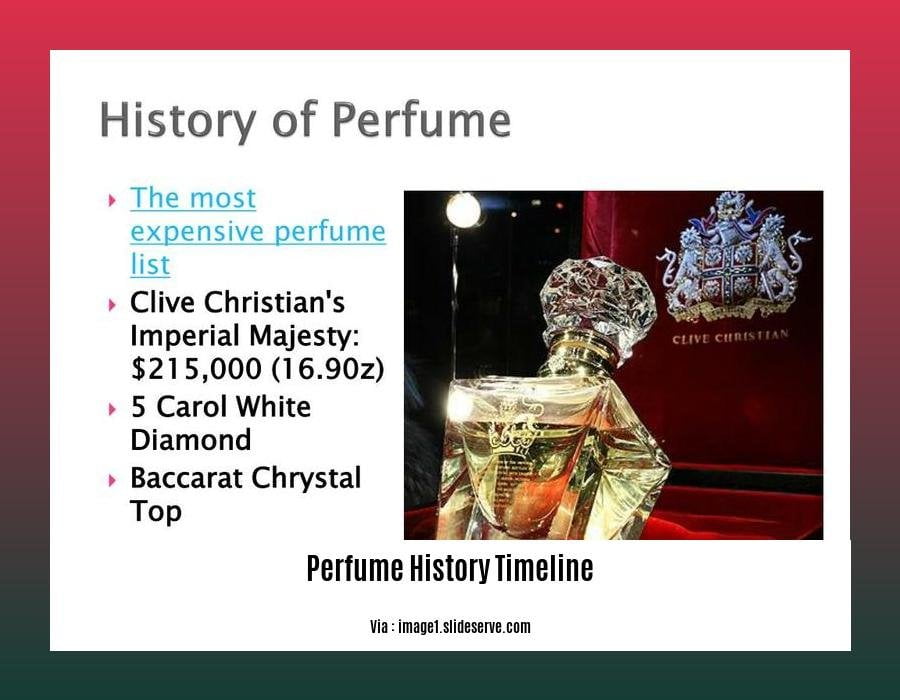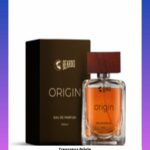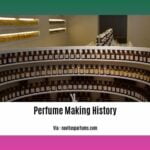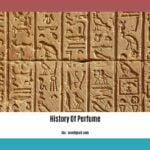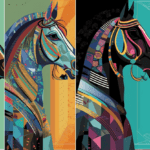Embark on a captivating voyage through time with our comprehensive perfume history timeline. From the aromatic rituals of ancient civilizations to the modern-day masterpieces that grace our vanity tables, this timeline traces the captivating evolution of fragrance across centuries and cultures.
Key Takeaways:
- Perfume has been used since ancient times, with the earliest known discoveries dating back to 3000 BC in Egypt.
- Ancient civilizations such as Egypt, China, and India played a significant role in the development and refinement of perfumery.
- Perfumes held religious and symbolic significance in ancient cultures, often used as offerings to gods and in rituals.
- The Moors introduced the concept of perfumery to Europe in the 14th century.
- Hungary Water, introduced by the Hungarians, was the first modern perfume, blending scented oils with alcohol.
- The term “perfume” originates from the Latin word “perfumare,” meaning “to smoke through.”
- Modern perfumes typically consist of denatured ethyl alcohol and essential oils.
Perfume History Timeline
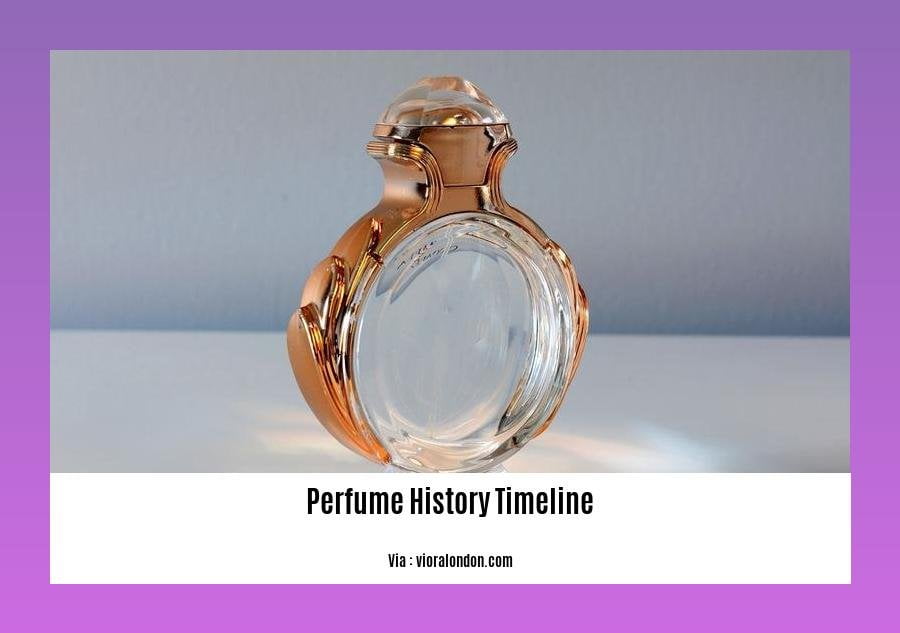
Let’s Embark on a Journey Through Time to Explore the Alluring History of Perfume
The perfume history timeline is a fragrant narrative spanning millennia, intertwining with cultures, civilizations, and human emotions. From its humble beginnings in ancient civilizations to the sophisticated creations of today, perfume has captivated our senses and left an indelible mark on our history.
Prehistoric Era:
- Fragrant plants and flowers adorned humans as amulets, warding off evil spirits.
Ancient Egypt:
- Egyptians mastered the art of perfumery, using fragrant oils for religious rituals and personal adornment.
- The first known perfumery was established in Memphis.
Mesopotamia:
- Sumerians developed techniques to extract fragrances from plants, creating perfumes for royal courts and temples.
Ancient Greece:
- Perfumes became symbols of luxury and refinement, with aromatic baths and scented oils becoming commonplace.
Roman Empire:
- Romans embraced perfume practices, with Cleopatra’s legendary blend becoming a testament to the empire’s opulence.
Middle Ages:
- Religious restrictions diminished the use of perfume, yet fragrant herbs still served medicinal purposes.
Renaissance:
- The rediscovery of ancient texts revived perfume-making in Europe, with perfumes becoming prized by the upper classes.
18th and 19th Centuries:
- Synthetic fragrances expanded the range of scents, making perfumes more accessible.
20th and 21st Centuries:
- Perfume technology evolved, creating new accords and fragrances.
- Natural and organic perfumes gained popularity.
Discover the captivating history of perfume and its captivating journey through time at history of perfume. Delve into the enigmatic origins of fragrance, uncovering its ancient roots and allure in fragrance origin. And witness the evolution of perfume making, from its humble beginnings to its modern-day artistry, in perfume making history.
Middle Ages (500-1500 CE)
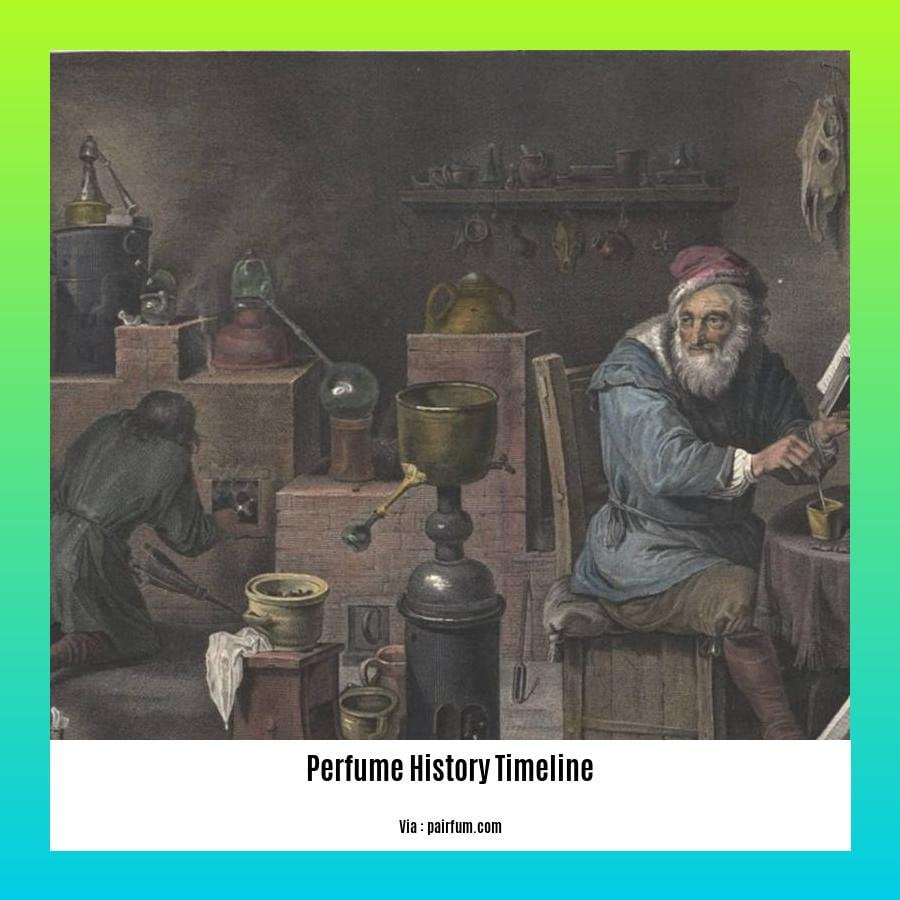
Religious and cultural prohibitions during this era led to a decline in perfume use.
Key Takeaways:
- Despite the decline in perfume use, fragrant herbs and flowers continued to be employed for medicinal purposes.
- The Middle Ages also witnessed the introduction of eggs and floral perfumes to Europe, brought by crusaders and trade with the Islamic world.
Citation:
- Perfumes Used in the Middle Ages:
18th and 19th Centuries
The Fragrance Revolution
The 18th and 19th centuries marked a transformative era in perfumery, one where synthetic fragrances emerged and the accessibility of perfume expanded to unprecedented levels.
During this period, chemists began experimenting with new ways to create scents, leading to the development of synthetic fragrances. These lab-created scents opened up a vast array of possibilities, allowing perfumers to craft fragrances that were once unattainable using natural ingredients alone.
Simultaneously, the Industrial Revolution brought about advancements in production and distribution, making perfume more affordable and accessible to the masses. This democratization of fragrance led to a surge in popularity, as people from all walks of life embraced the allure of scent.
Key Takeaways:
- Synthetic fragrances revolutionized perfumery, expanding the range of available scents.
- The Industrial Revolution made perfume more accessible to the general public.
- Perfume became a staple in personal grooming and self-expression.
Citation:
- The History of Perfume
20th and 21st Centuries
From the vibrant 20th to the innovative 21st century, perfume’s captivating allure continues to unfold. The rise of synthetic fragrances expanded the aromatic palette, making perfumes more accessible and diverse.
The atomizer, a revolutionary invention, transformed the perfume experience. Fragrances could now be applied with precision, allowing for personalized scent journeys.
In the 21st century, the focus shifted towards natural and organic perfumes. Consumers sought fragrances that harnessed the power of botanicals, prioritizing sustainability and well-being.
Key Takeaways:
- Synthetic fragrances expanded the range of scents.
- Atomizers revolutionized perfume application.
- Natural and organic perfumes prioritize sustainability and well-being.
Relevant URL Source:
FAQ
Q1: When did humans first start using perfumes?
A1: The earliest recorded use of perfumes dates back to ancient Egypt around 3000-1000 BC, where scented oils were employed in religious ceremonies.
Q2: What is the origin of the word “perfume”?
A2: The term “perfume” stems from the Latin word “perfumare,” which means “to smoke through.” This refers to the practice of burning incense and herbs for aromatic purposes in ancient times.
Q3: What were the main ingredients used in early perfumes?
A3: Ancient civilizations utilized a range of natural ingredients to create scents, including essential oils extracted from plants, flowers, and spices, as well as animal glandular oils for musky aromas.
Q4: When was the first modern perfume introduced?
A4: The first modern perfume, known as “Hungary Water,” was created in 1370 by the Hungarians. It was a blend of scented oils dissolved in an alcohol solution.
Q5: How are modern perfumes typically composed?
A5: Contemporary perfumes generally consist of a combination of denatured ethyl alcohol as the base and various scented essential oils, which are blended in specific proportions to create unique fragrances.
- Crypto Quotes’ Red Flags: Avoid Costly Mistakes - June 30, 2025
- Unlock Inspirational Crypto Quotes: Future Predictions - June 30, 2025
- Famous Bitcoin Quotes: A Deep Dive into Crypto’s History - June 30, 2025
